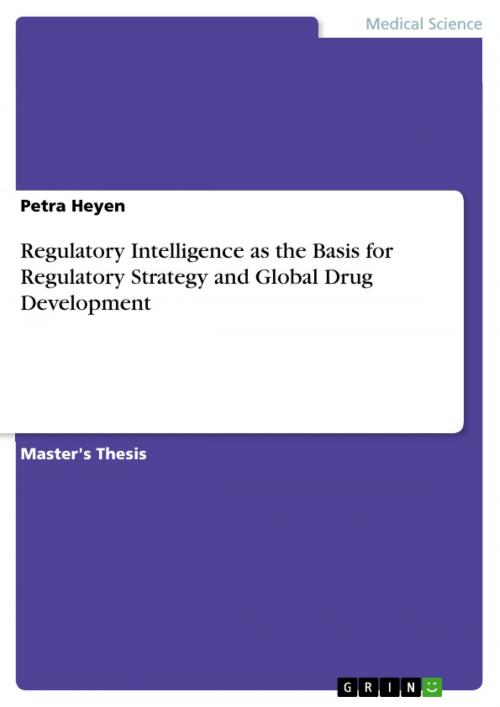Regulatory Intelligence as the Basis for Regulatory Strategy and Global Drug Development
Nonfiction, Health & Well Being, Health| Author: | Petra Heyen | ISBN: | 9783638372015 |
| Publisher: | GRIN Publishing | Publication: | April 28, 2005 |
| Imprint: | GRIN Publishing | Language: | English |
| Author: | Petra Heyen |
| ISBN: | 9783638372015 |
| Publisher: | GRIN Publishing |
| Publication: | April 28, 2005 |
| Imprint: | GRIN Publishing |
| Language: | English |
Master's Thesis from the year 2004 in the subject Health Science, grade: sehr gut, University of Bonn (Mathematisch-Naturwissenschaftliche Fakultät), 24 entries in the bibliography, language: English, abstract: The Regulatory Affairs (RA) department is a key discipline in the global network of drug development. During drug development, regulatory strategy is one crucial success factor for the approval of the development candidate. Also, regulatory strategy can optimise labelling in the key countries in order to maximise the market success. No submission and approval would be possible without the appropriate dossier composition and compilation. Without adherence to the respective guidance documents and scientific advice from Health Authorities to design the optimal clinical development plan, optimal labelling would not be feasible. These two examples show some characteristics of the regulatory strategy: it is highly interactive with other disciplines and it is heavily based on a thorough intelligence work which enables the RA Manager to know the 'rules of the game' and to develop the optimal regulatory strategy for the current development candidate. The major cornerstone for developing a regulatory strategy is regulatory intelligence. This document focuses on regulatory intelligence. The regulatory contributions to the global drug development from early research to submission are described. Strategies for generic drugs as well as detailed strategies for life-cycle management are excluded. Major components of regulatory intelligence are: •Competitor Information •Information on Regulatory Environment •Information on Legal Requirements Competitor analysis is an essential aspect of the intelligence work. Sources of competitive information as well as relevant items of competitive information are described. Sources of information about the regulatory environment and sources of information about the legal regulatory environment are described and their tremendous impact on setting up and modifying the regulatory strategy evaluated. Special attention is paid to the components and sources of regulatory intelligence information (e.g. Internet links and documents related to intelligence information). Some examples show how regulatory intelligence information supports the regulatory strategic considerations. The last section describes the regulatory strategy itself and examples of how regulatory intelligence acts as the basis for setting up the regulatory strategy. What is the basis of strategic considerations, what are the considerations, what are the major components of a regulatory strategy, how do the different disciplines involved in drug development work together?
Master's Thesis from the year 2004 in the subject Health Science, grade: sehr gut, University of Bonn (Mathematisch-Naturwissenschaftliche Fakultät), 24 entries in the bibliography, language: English, abstract: The Regulatory Affairs (RA) department is a key discipline in the global network of drug development. During drug development, regulatory strategy is one crucial success factor for the approval of the development candidate. Also, regulatory strategy can optimise labelling in the key countries in order to maximise the market success. No submission and approval would be possible without the appropriate dossier composition and compilation. Without adherence to the respective guidance documents and scientific advice from Health Authorities to design the optimal clinical development plan, optimal labelling would not be feasible. These two examples show some characteristics of the regulatory strategy: it is highly interactive with other disciplines and it is heavily based on a thorough intelligence work which enables the RA Manager to know the 'rules of the game' and to develop the optimal regulatory strategy for the current development candidate. The major cornerstone for developing a regulatory strategy is regulatory intelligence. This document focuses on regulatory intelligence. The regulatory contributions to the global drug development from early research to submission are described. Strategies for generic drugs as well as detailed strategies for life-cycle management are excluded. Major components of regulatory intelligence are: •Competitor Information •Information on Regulatory Environment •Information on Legal Requirements Competitor analysis is an essential aspect of the intelligence work. Sources of competitive information as well as relevant items of competitive information are described. Sources of information about the regulatory environment and sources of information about the legal regulatory environment are described and their tremendous impact on setting up and modifying the regulatory strategy evaluated. Special attention is paid to the components and sources of regulatory intelligence information (e.g. Internet links and documents related to intelligence information). Some examples show how regulatory intelligence information supports the regulatory strategic considerations. The last section describes the regulatory strategy itself and examples of how regulatory intelligence acts as the basis for setting up the regulatory strategy. What is the basis of strategic considerations, what are the considerations, what are the major components of a regulatory strategy, how do the different disciplines involved in drug development work together?















